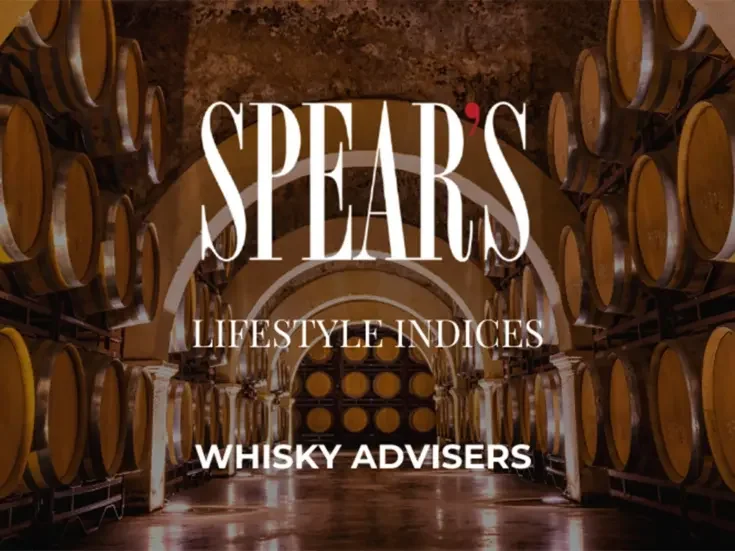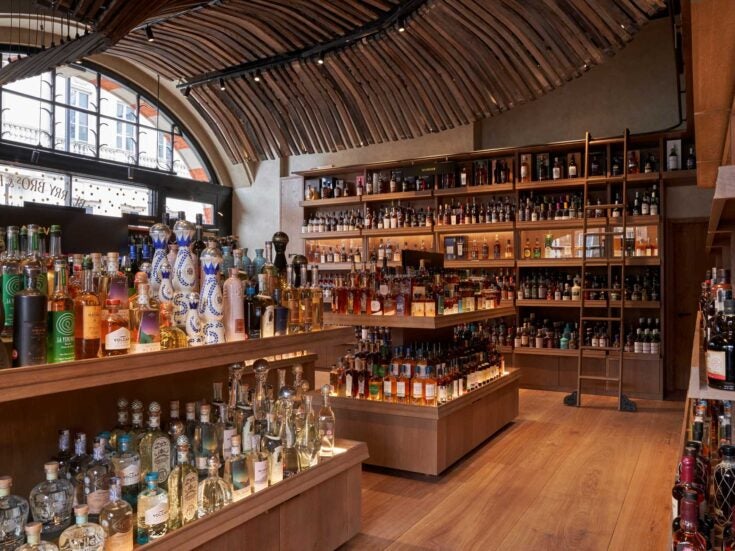
In Vino Vitalie
Vitalie Taittinger’s family liked the champagne so much they bought the company and gave it their name. The effervescent heiress spills all to Josh Spero
‘CHAMPAGNE IS TO the brain, to the hidden brain!’ says Vitalie Taittinger joyfully. ‘With champagne you can tell everything, it is a serum of truth, it helps everybody to be more close to what they are.’ She draws out ‘serum of truth’ as if she is slyly revealing a secret. This seems like a mischievous position for the director of marketing for a champagne house, especially one who is splitting a delicious bottle of Taittinger Cuvée Prélude ‘Grand Crus’, golden bubbles effervescing on the navy blue foil, with a journalist over an elaborate lunch.
As we talk about what champagne signifies — a social marker, taste, love, fashion — our seventh course is painstakingly laid out on the table. A large silver cocoa pod is opened to show slim strips of chocolate filled with praline. A silver tray with two rectangles of grapefruit marshmallow on it has, attached to it by a heavy silver chain, a pair of large silver scissors to cut the marshmallow. A silver lid engraved with ‘Lallemand’, the name of the chef at L’Assiette Champenoise in Reims, is removed from a silver box which contains individually wrapped bites of nougat and toffee and red and green lollipops. And on it goes. I can’t tell if Taittinger is amused by the parade or by my bemusement and hungry eyeing-up of the sweets.

Vitalie refers to the origins of champagne — ‘The tradition of champagne was to make a good party for the king with the ladies, to make him forget everything’ — when she elaborates on its enduring charm, but the point is also that hers is just as social a business. Unlike larger houses — Taittinger produces 5.2 million bottles a year, Moët 26 million — which are owned by global luxury corporations, Taittinger has to be run on a much more personal level. What else could explain a two-day trip to the tiny market of Andorra for a dinner with a supplier? ‘Every market is important. When you are a family business, we do the wine but we are supporting it with family spirit. For us it’s very important to meet those who are our friends.’
It’s not only local principalities which receive flying visits. Taittinger has just got back from China, which is a tiny market today — 40,000 bottles for Taittinger — trying to promote her brand to hotels, which is where expats used to a champagne culture can mix with locals. If there is a more effective symbol of the triumph of capitalism in China than the popping of champagne corks in Shanghai, it has not yet been invented.
The March 2011 Champagne Update Briefing from the Comité Champagne has good news on the export front: 134.5 million bottles were exported in 2010, sharply up on 2009 but well below the 2007 peak, with biggest importer Britain up 16 per cent, the US 35 per cent and Germany 22 per cent. The figures from emerging markets, albeit from low bases, were even more encouraging: Russia and China were both up 90 per cent to 1.1 million, Brazil rose by two-thirds to a million and supposedly dry UAE is looking rather wet, up 40 per cent to 1.2 million bottles.

Not all these markets are ideal for smaller exporters. ‘In Russia, it’s very hard with the structure of the economy,’ Taittinger says. ‘We have a very good distributor, but you go very carefully because we are not bling-bling.’
THE HOUSE NOW known as Taittinger dates back to 1734, when it was founded on what are now the outskirts of Reims by Jacques Fourneaux. In 1932 it was bought by Pierre Taittinger, Vitalie’s great-grandfather, after he had fallen in love with its headquarters, the Château de la Marquetterie, as an officer billeted there during the First World War. Although Taittinger is again a family business, its tumultuous recent past has seen it owned by the Starwood Group, better known for hotels and resorts than cuvées and corks, to which it was sold in 2005 by some branches of the family who didn’t actually work in the business and from which it was bought two long years later by Vitalie’s father, Pierre-Emmanuel.
For Vitalie, who at 32 resembles a young Brigitte Bardot, ‘It was very hard — we never wanted to sell the company. My father never wanted to sell the company and for him it was a nonsense, like cutting off your arm. My father continued to work when it was Starwood and he decided to buy back the company because he was convinced — it’s the story of him. He is very linked to his family, the history of his family. He’s proud of that.’
The advantages of being family-owned are clear, too: ‘To be a family business gives you the chance to say, “I want to do that.” It’s not an economic choice — it’s just a question of who we are. It gives you a certain freedom to do what you want. It’s the same for all family businesses — it’s a way to drive a company with a certain part of originality or creativity. You have something which is not run by the figures.’
The family history persuaded Pierre-Emmanuel to buy it back, but it did not weigh down on him when he decided to make a suite of changes. Following best environmental practice, led by the forward-thinking Comité Champagne, they have been working on a lighter bottle, refining their logistics and changing their approach to their 300 hectares of vineyards without rushing into ‘a go-go-go-go biodynamic, bio-organic’ system.
Not that climate change is entirely bad for vineyards, as Taittinger concedes with another mischievous smile. Hotter climates make better grapes: ‘It’s a fact. We had the past ten years which were totally beautiful, the condition was optimal, and you’re right — it was good. But you can see in a lot of places in the world that the weather is changing radically, very violently, it’s not good at the end.’
If the grapes threaten to become overripe and too sweet, you can harvest them early or mix the champagne slightly differently. Taittinger has always been mixed differently, using much more Chardonnay and less Pinot Noir and Pinot Meunier in its mixture than other houses, making it lighter but a little less dry.
If the environmental climate has been warm, the financial one has been scorching. When I try to draw her out on what the potential collapse of the euro would mean for Taittinger (seven of the top ten champagne-importing markets would probably head straight into recession), Taittinger demurs and says it’s a question for her father or her brother Clovis, responsible for exports.

She is frank about the problems France is facing internally, however, perceiving a decline in the standards of French society and governance. People work harder but ‘we have lost the sense of reality in a lot of parts of the life, the economic one. It doesn’t work — we can feel that every day — you are fighting against it. I think it’s less fun than before in Paris. You can really feel that there are some tensions — people are all in the competition.’
AFTER OUR LUNCH has concluded and we are heading to the Taittinger cellars, I see another recent innovation: above the cellars is a sparkling visitor centre, with a bright white bar where a dozen or so middle-aged French people were enjoying a glass of champagne. It gets 50,000 visitors a year, but not all its treasures are on show. For example, Taittinger has commissioned eleven artists since 1983 to decorate a bottle and some of the hand-made designs are in one private room: the bottle Roy Lichtenstein himself painted is there, as are several attempts by Victor Vasarely, individual tiny tiles cut and stuck on to bottles to create his famous bulging pattern.
Back on the public tour, stretching 50 metres below the ground, are the chalk quarries first used by the Romans which serve as the house’s cellars. Perpetually chilly, the caves stretch for miles and although they don’t have a miniature train like Pommery’s to take you around, the three million bottles laid up in A-frames and in tight lattices are impressive nonetheless. One room has 72,000 bottles packed into it. There are standard bottles, magnums, jeroboams and rehoboams, each waiting to be turned by hand, and one cave behind an iron gate has the Taittinger archive. Because the centre is on the site of a 13th-century church, there are occasional rustic saints carved out of the chalk in niches and stairs which once led up to the church kitchen or the vestry.
Touring the caves is an astonishing experience which puts the hectic enjoyment of champagne at parties and in clubs into a much longer perspective. Indeed, the long, if briefly broken, ownership of the Taittingers recedes too beneath ground. What strikes you is the eternity of viticulture in the region, back to Thibaud IV, who brought Chardonnay from Cyprus, and beyond Thibaud to the Romans. The Taittingers are part of this much greater tradition, whose length you measure not in centuries or seconds but by how long the bubbles in that glass of Taittinger Prélude continue to rise, rise, rise.
Josh Spero is Spear’s editor
Don’t miss out on the best of Spear’s articles – sign up to the Spear’s weekly newsletter
[related_companies]







